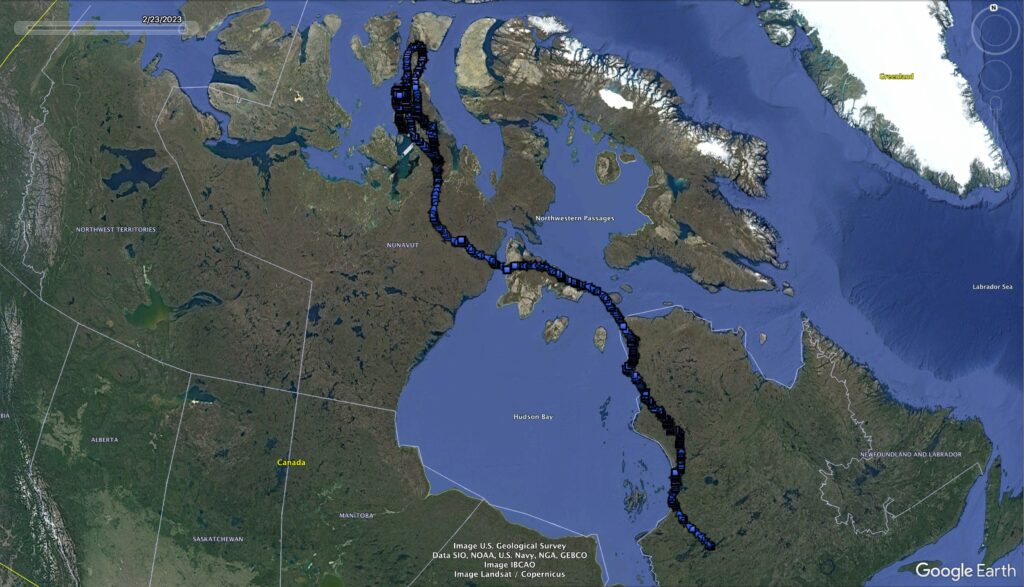
Alderbrooke’s 2022 movements into the central Canadian Arctic, from April to the end of August. (©Project SNOWstorm and Google Earth)
We’re usually on tenterhooks in late autumn and early winter — from about mid-November to the end of December — expecting to hear from the first returning tagged snowy owls. As we’ve mentioned before, this was a very slow year on that front — just two returning veterans, Columbia and Otter, compared with a more typical winter like 2021-22 when there were nine.
We’re not sure why the numbers were so low; one grim possibility is that avian influenza has taken an even harsher toll than we realized. This past week I heard from our colleague, Dr. Karen Wiebe at the University of Saskatchewan, that the number of returning tagged owls from their telemetry project on the Canadian prairies was similarly low this winter.
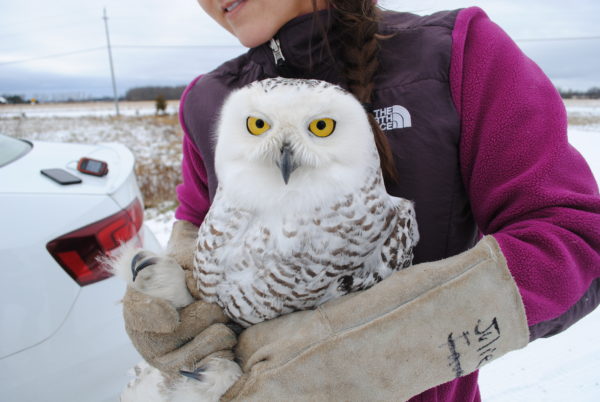
Becca McCabe with Alderbrooke in Dec. 2020. (©Project SNOWstorm and Google Earth)
All of which made the big news of the past week all the more surprising and encouraging. Alderbrooke, a female snowy owl tagged as a juvenile in Dec. 2020 by Becca McCabe at Montréal, unexpectedly connected last Friday, Feb. 17.
This was a double shock because, frankly, we’d given up Alderbrooke for lost. Last winter she came south after spending the summer in the Ungava Peninsula of northern Québec, uploading her data on Nov. 18, 2021 near lac Saint-Jean, QC…and then went dark. For the rest of the winter, we heard from her only on the first of each month (when the transmitters are programmed to send, if nothing else, an electronic “Here I am!” signal), but those transmissions never included any data, or even her current location.
All we could assume was that something bad had happened to Alderbrooke after she returned south, and assumption that was reinforced this winter when there was no further sign of her at all. So to see her reappear and upload 11,500 GPS locations, tracking her 2022 migration north up the Ungava, across Hudson Bay and far in the central Canadian Arctic on the Boothia Peninsula and King William Island, was a happy gobsmack.
Unfortunately, the story wasn’t complete. The GPS data ended Aug. 30, when she was still in the far north, and there was no current location data to tell us where she was at the time she connected. She obviously wasn’t still in the Arctic, far from any cell signal. Her battery voltage was very low, but the accelerometer data indicated a healthy level of daily activity, so she was also obviously alive. There may be a malfunction in the transmitter, or Alderbrooke may be one of those owls (we’ve had a few) that so thoroughly preen their transmitter deep into their back feathers that the solar panel never gets enough direct sun to charge properly.
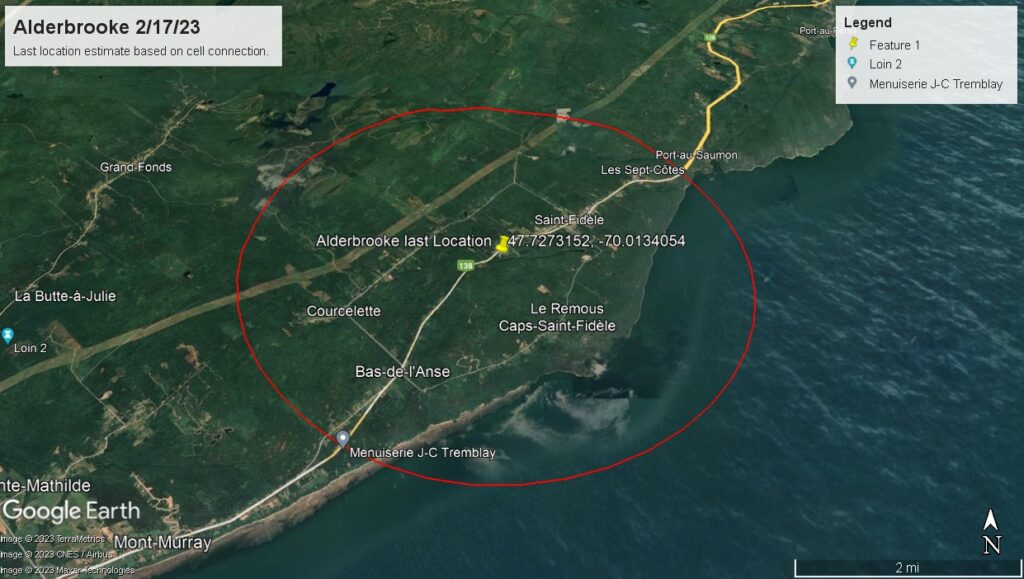
Based on her cell signal, Alderbrooke was somewhere in this area of southeastern Québec when she checked in Feb. 17. (CTT)
I asked Jess Formento, part of our regular SNOWstorm team, to see if she and her colleagues at CTT, the company that makes our transmitters, could take a look under the hood, so to speak, since they have access to much more detailed data than we can see through our online user interface. They were able to use the ID of the Bell cellular tower through which latest connection was made to determine that Alderbrooke is on the north shore of the St. Lawrence River a few kilometers east of La Malbaie, QC, about 130 km (80 miles) east of Québec City. Unfortunately, this approach doesn’t give us the kind of pinpoint accuracy we get with our normal GPS locations. Instead, we know she was plus or minus about 4,700 meters from a central point — a circle about 10 km (6 miles) in diameter.
That general location, though, fits with her movements last year; it seems likely she passed again near Lac Saint-Jean to the northwest on her way south. I checked eBird to see if anyone had reported (or better yet, photographed) a snowy owl in the vicinity of La Malbaie, but the only report in that entire area this winter was a single sighting back in November, quite a long way to the west, without a photo.
We’re not sure whether we’ll get more data from Alderbrooke this winter, though we’re hopeful that longer days and higher solar angle may help recharge her battery. But we’re keeping our fingers crossed, because she’s certainly surprised us once already.
* * * * *
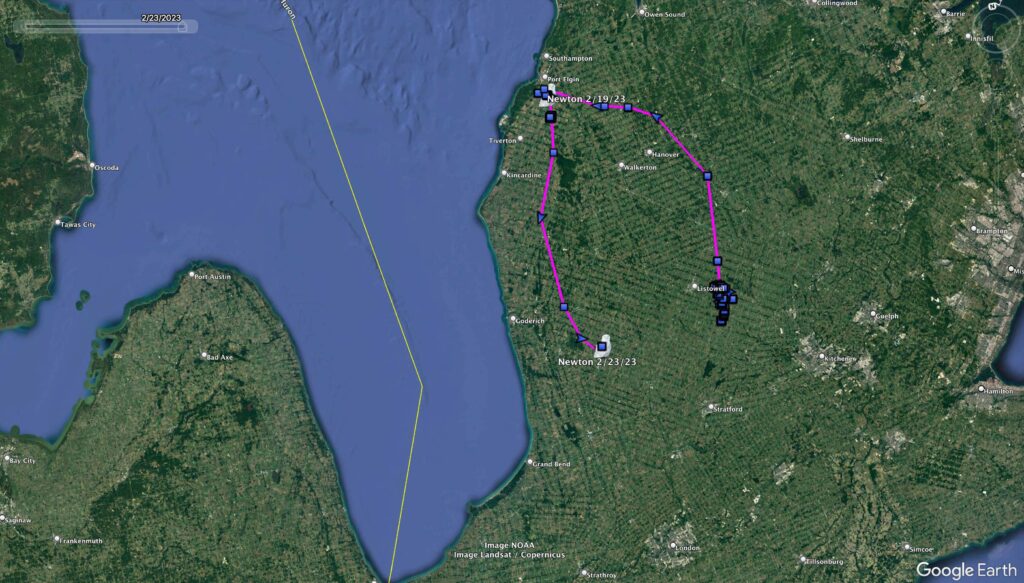
The first tug of spring? Newton showed some uncharacteristic wanderlust. (©Project SNOWstorm and Google Earth)
There’s not a lot of change to report with the other five owls we’ve been tracking all winter — with the exception of Newton, who until now has been the most sedentary of the bunch, remaining in a small area of farmland in southern Ontario close to where he was tagged. On Feb. 18-19, though, Newton up and moved 64 km (40 miles) northwest, close to the shore of Lake Huron near Port Elgin, ON, then on Feb. 23 flew 91 km (56 miles) due south to near Seaforth, ON.
Why? We’d have to ask Newton, but I suspect the longer days are starting to exert their influence on these adult owls — and especially on adult males like Newton, who need to head north fairly early so they can prospect for potentially good nesting areas with high lemming populations, set up a territory and start trying to attract a mate.
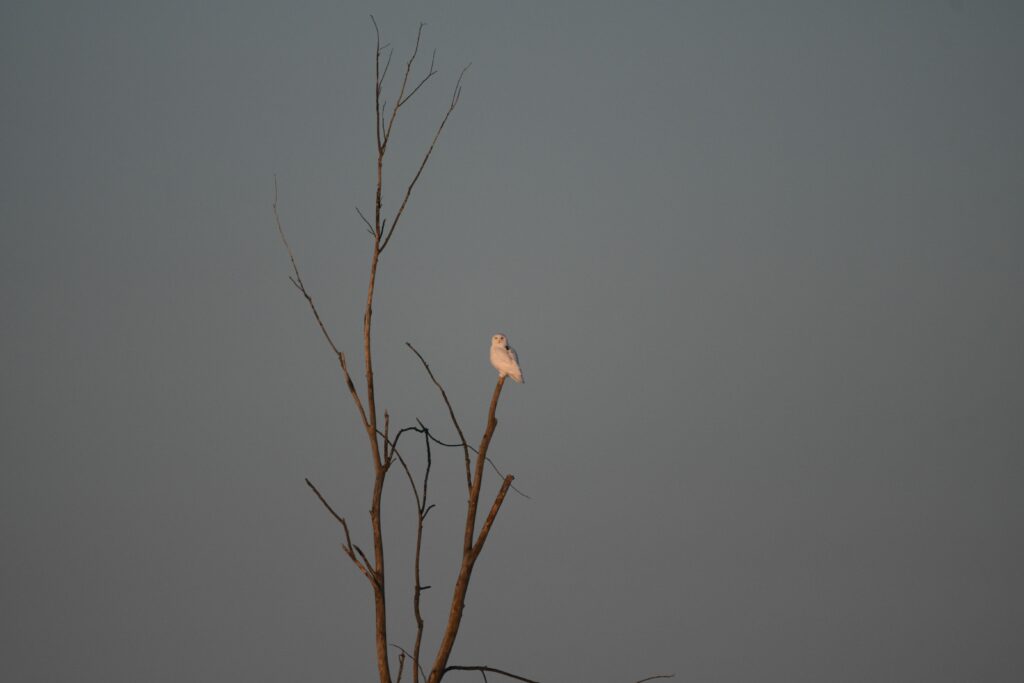
Otter, ready to start his nocturnal hunt. (©Dan LaFortune)
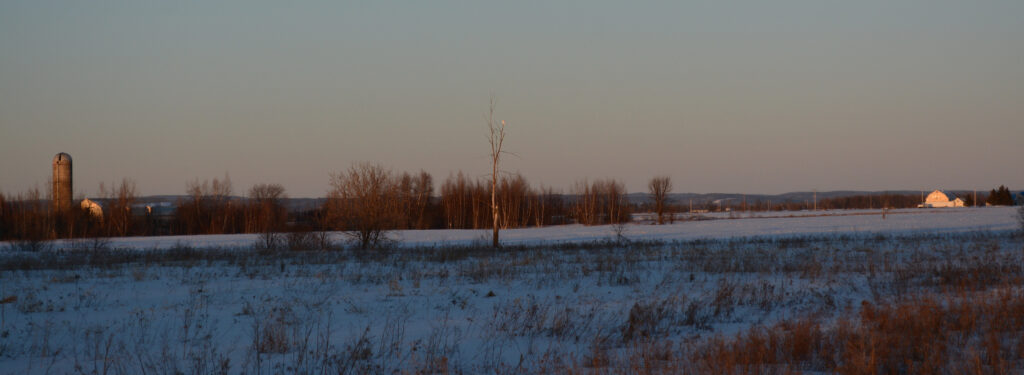
The witching hour for a hungry snowy owl. (©Patricia LaFortune)
But spring is still just a whisper; the other owls — Otter, Columbia, Huron and Salyer — all seem content where they are, at least for the moment. Last weekend our old friends Patricia and Dan LaFortune from Ottawa were able to spot Otter, coming off his day roost to a high perch in the late sun as he began his evening hunt, and they were kind enough to share some photos of the old boy, glowing in the sunset light.


9 Comments on “A Big (Pleasant) Surprise”
I wonder if Newton would have continued across Lake Huron if it had been frozen, which I imagine it is not due to the warm winter (in general) we’ve been having. Maybe the expanse of open water turned him back?
We’ve seen in past, more typically cold, years that snowy owls *love* ice, so you may well be right.
Hi
As far as the number of owls coming back on the radar so to speak. what would the average be for a year? I’m assuming three is a low number.
It is — six to nine is more typical.
Great news about Alderbrooke and stunning pictures of Otter!
Thanks for all your work.
Glad to hear the good news about Alderbrooke! Like I always say never give up! Will be interesting to see what happens next winter.
We’ve had continuous sightings since January of at least 2 snowies.
Also a few short eared owls in same area(unusual) near airport in Grand Rapids, MI.
Happy to hear the good news about Alderbrooke!! You never know, maybe his Tx will connect again.
It was great to spot Otter, he was looking very beautiful in the sunset light.
Thanks for keeping us updated!!
Happy to hear the good news about Alderbrooke!!! Yu never know, he may check in again soon.
It was great to spot Otter, he was looking very beautiful in the sunset light.
Thanks for keeping us updated!!